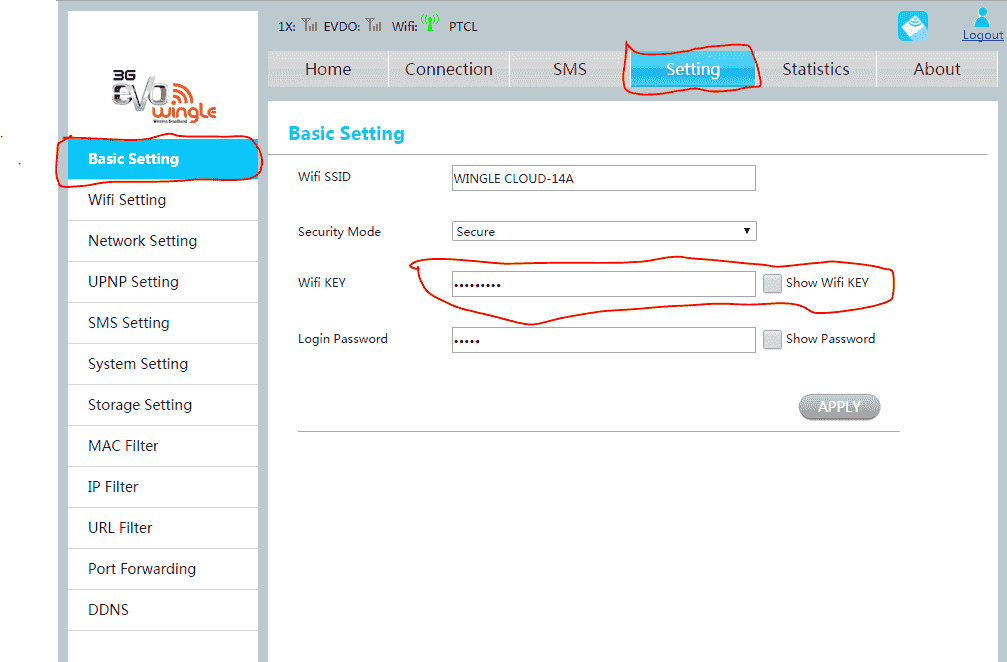Managing your Evo Wingle password is an essential part of keeping your internet connection secure and optimized. In the digital age, protecting your network from unauthorized access is more important than ever. With a few simple steps, you can easily change your Evo Wingle password, ensuring that only you and those you trust can access your internet connection. In this post, we'll explore why you should consider changing your password regularly and how to do it effortlessly.
Why You Should Change Your Evo Wingle Password

Changing your Evo Wingle password isn't just about keeping your network secure; it also plays a vital role in enhancing your overall online experience. Here are several compelling reasons why you should take the time to update your password:
- Enhanced Security: One of the primary reasons to change your password regularly is to strengthen your network's security. Over time, unauthorized users may gain access to your network, whether through hacking attempts or by exploiting weak passwords. By changing your password periodically, you minimize the risk of someone using your connection without your permission.
- Prevent Unauthorized Access: If you've shared your Evo Wingle password with family or friends, there's always a chance it could fall into the wrong hands. Changing your password ensures that only those you trust have the ability to access your network.
- Protect Sensitive Information: If you use your internet connection for online banking or shopping, a strong password is essential. Changing your Evo Wingle password can help safeguard your personal information from cybercriminals.
- Stay Compliant: For businesses that use Evo Wingle for their operations, it’s crucial to adhere to compliance regulations regarding data protection. Regularly changing passwords helps maintain best practices in cybersecurity.
- Peace of Mind: Knowing that you have a strong, updated password can provide a sense of security. You can browse freely without worrying about potential intrusions.
To make your password more effective, here are a few tips:
- Use a mix of characters: Combine uppercase letters, lowercase letters, numbers, and special symbols.
- Avoid common passwords: Steer clear of easily guessable passwords like "123456" or "password".
- Consider a password manager: If you struggle to remember complex passwords, a password manager can help keep them all organized and secure.
In conclusion, changing your Evo Wingle password is a simple yet effective way to enhance your network security and protect your online activity. Whether for personal use or as part of a business strategy, keeping your password fresh is a smart move that pays off in peace of mind. So, don’t hesitate—make it a habit to review and update your password!
Also Read This: Monetization Basics: How to Enable It on Your Dailymotion Channel
3. Pre-requisites for Changing Your Evo Wingle Password
Before diving into the process of changing your Evo Wingle password, it's vital to ensure you have a few things sorted out. Having everything in place will help make the transition smooth and hassle-free. Let's take a look at the essentials:
- Access to Your Evo Wingle Device: Make sure you have your Evo Wingle device readily available. You’ll need it to connect to the interface where you'll change the password.
- Current Password: It's crucial to have your existing password handy. If you’ve forgotten it, you may need to reset your device, which can be a bit more complex.
- Internet Connection: Ensure you're connected to the internet. This could mean connecting through your mobile device or via a computer that's linked to the Evo Wingle network.
- Web Browser: Use a reliable web browser. Google Chrome, Mozilla Firefox, or Safari are great choices. Make sure your browser is updated to avoid any compatibility issues when accessing the device interface.
- Device IP Address: Know the default IP address for your Evo Wingle. Generally, it’s either 192.168.1.1 or 192.168.8.1. You’ll be prompted to enter this in your browser’s address bar to access the settings.
- Device Manual (Optional): If you have the manual for your Evo Wingle, keep it nearby. It can be a handy reference, especially for troubleshooting and clarifying any specific terms.
- Backup Your Settings (Optional): If you’re not familiar with the configuration options of your Evo Wingle, consider backing up your current settings first. This way, you can restore them easily if something goes awry.
Once you have these pre-requisites in check, you’ll be well-prepared to change your password without any hitches. Ready? Let’s move on to the step-by-step guide!
Also Read This: How to Make Easy Donuts: Fun and Easy Recipe on Dailymotion
4. Step-by-Step Guide to Change Your Evo Wingle Password
Changing your Evo Wingle password is a straightforward process, but it's essential to follow each step carefully. So, without further ado, here are the simple steps to get that new password set up!
- Connect to Your Evo Wingle: Open your web browser and ensure your computer or device is connected to the Evo Wingle network. You’ll be using this connection to access the device settings.
- Enter the IP Address: In the address bar, type in the default IP address of your device (e.g., 192.168.1.1 or 192.168.8.1) and press Enter.
- Login to the Admin Panel: A login screen will appear. Input your current username and password. The default username is usually admin and the default password might also be admin or password, unless you’ve changed it before.
- Navigate to Settings: Once logged in, look for a section that says Settings or Wi-Fi Settings. It’s typically found in the main menu or submenu options. Click on it.
- Find the Password Option: Within the Wi-Fi settings, you should see an option for Wireless Security or something similarly named. Here’s where you’ll find the field to change your password.
- Change Your Password: Enter your new password in the designated field. Make sure to choose a strong password – mix letters, numbers, and special characters for better security. A good habit is to write it down temporarily until you remember it.
- Save Your Changes: After entering the new password, look for a button labeled Save or Apply Changes. Click it to ensure your new settings are recorded.
- Reconnect to the Network: Since you have changed the password, you’ll need to reconnect your devices to the Evo Wingle network using the new password.
- Test Your Connection: Finally, make sure everything is working by testing your internet connection. Open a new tab and visit a website to confirm you're online.
And there you have it! Changing your Evo Wingle password is now complete. Doing this regularly can enhance your network’s security and keep unwanted guests out. If you have any further questions or run into issues during the process, feel free to consult the user manual or seek help online!
Also Read This: How to Make a Flower with Paper: Easy Crafting Tutorial on Dailymotion
Troubleshooting Common Issues When Changing Passwords
Changing your Evo Wingle password should be a straightforward process, but sometimes things don’t go as planned. Here are some *common issues you might encounter and simple solutions to get you back on track:
- Can’t Log In: If you can't log in after changing your password, double-check that you’re entering the correct username. Make sure you are typing the new password accurately, paying attention to any uppercase and lowercase letters, as passwords are case-sensitive.
- Error Messages: If you receive an error message while trying to update your password, it may be due to a weak password or a temporary issue with the server. Try waiting a few minutes before retrying, or ensure your new password meets the settings requirements*.
- Forgotten Password: If you forget your new password right after changing it, don’t panic! Use the “Forgot Password?” feature on the login page to reset it. Follow the instructions provided, and check your email (including your spam folder) for the reset link.
- Inconsistent Access: If you're able to log in with the new password sometimes but not always, consider clearing your browser's cache or trying a different browser altogether. Occasionally, cached pages can cause login inconsistencies.
If you continue to experience problems despite following these troubleshooting tips, it might be time to reset your Evo Wingle device. Simply restart it by removing it from power for about 30 seconds before plugging it back in. This can often resolve lingering issues.
Also Read This: Delicious Creamy Coffee Recipe on Dailymotion
How to Create a Strong Password for Your Evo Wingle
Creating a strong password is one of the most effective ways to protect your Evo Wingle from unauthorized access. Let’s explore some easy tips on how you can craft a password that keeps your network secure:
- Length Matters: Aim for at least 12-16 characters. The longer the password, the harder it is for attackers to crack it.
- Use a Mix of Characters: Combine upper and lowercase letters, numbers, and special characters (like !, @, #, $, etc.). For example, instead of "password," try "Pa$$w0rd1!" which is much harder to guess.
- Avoid Common Words: Steer clear of easily guessable terms. This includes names, birthdays, or favorite sports teams. Consider using random words or a phrase that’s only significant to you. For instance, “BlueSky!Dolphin92” is memorable yet complex.
- Use Passphrases: A passphrase is a series of words or a sentence that you can remember easily. For example, “I1ove$unny^days!” is both unique and easy to remember.
- Regularly Change Your Password: Make it a habit to change your password every 3-6 months to maintain security. Set a reminder in your calendar to do this, and don't forget to log this update securely.
To summarize, creating a strong password for your Evo Wingle involves a mix of length, character diversity, and personalization. Take the time to choose or create a secure password that works for you and helps keep your internet connection safe from intruders. Your online safety is worth the effort!
Conclusion and Final Tips for Maintaining Your Evo Wingle Security
Changing your Evo Wingle password is just the first step in ensuring that your device remains secure. Once you've updated your password, it's essential to implement additional security measures to protect your network. Here are some final tips to keep your Evo Wingle and personal information safe:
- Regularly Update Your Password: Change your password every 3-6 months to reduce the risk of unauthorized access.
- Use Strong Passwords: Create complex passwords that include a mix of upper and lower case letters, numbers, and special characters. Consider using phrases for added security.
- Enable WPA3 Encryption: If your device supports it, always use the latest security protocols, such as WPA3, to encrypt your wireless connection.
- Disable WPS: Wi-Fi Protected Setup (WPS) can be vulnerable. Turn it off to enhance your network's security.
- Regular Firmware Updates: Keep your device's firmware up to date to protect against known vulnerabilities and bugs.
Additionally, keep an eye on the devices connected to your network. If you notice any unfamiliar devices, take immediate action to remove them and change your password. By following these tips, you can significantly enhance the security of your Evo Wingle and ensure a safer online experience.
In summary, by changing your password regularly, using strong security protocols, and staying vigilant, you can maintain the integrity of your Evo Wingle connection and protect your personal data from potential threats.
 admin
admin








